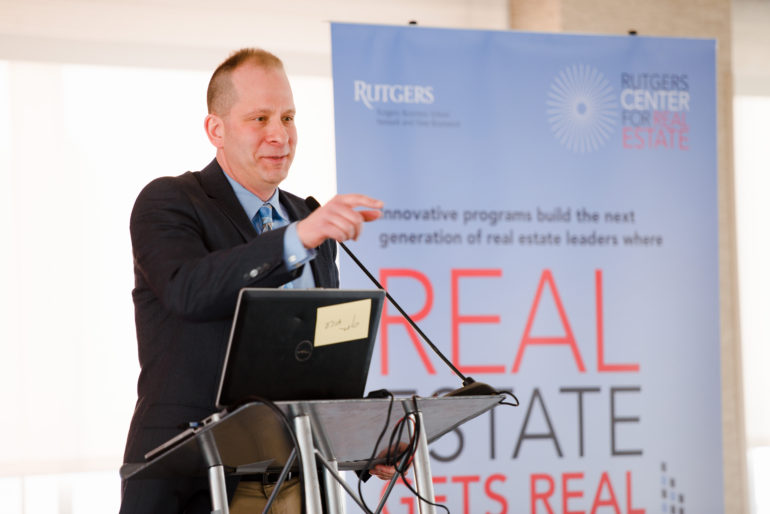Morris Davis, the Paul V. Profeta Chair of Real Estate and the academic director of the Center for Real Estate at the Rutgers Business School, spoke during the center’s Capital Allocation Conference on April 12 in Jersey City. — Photo by Fred Stucker/Courtesy: Rutgers
By Joshua Burd
A new study is shedding new light on a widespread, age-old debate between developers and local governments in New Jersey: Do new apartments mean new school-age children?
According to the findings, the answer depends on several key factors.
The white paper — released by the Center for Real Estate at Rutgers Business School — finds that the number of children living in new rental buildings is closely tied to renter household incomes, the number of bedrooms and a property’s age, density and location. Those findings come from a survey of more than 40,000 residential units across New Jersey over 18 months, in an effort by the center’s academic team and developers who serve on its board.
The center said the study, its first public policy white paper, provides “an unprecedented level of context” for what has long been a sticking point for developers and municipal officials. Its authors highlighted several key findings:
- Across all income levels and building product types, the number of school-age children increases with the number of bedrooms;
- For any given number of bedrooms and product types, the number of school-age children decreases as renters’ household incomes rise;
- Holding income and the number of bedrooms fixed, the amount of school-age children has an inverse relationship with density. For instance, garden apartments with fewer units per building have a greater number of school-age children, while mid- and high-rise buildings with more units per building have fewer school-age children;
- Buildings with an average income of less than $50,000 per year have a similar number of school-age children regardless of whether the buildings include affordable units or market-rate units;
- Buildings constructed before 2000 have a significantly higher number of school-age children living in market-rate units than do buildings built after 2000;
- On average, the number of school-age children per 100 affordable units is significantly higher than the number of school-age children per 100 market-rate units.
“The issue of school-age children in new multifamily development is frequently a contentious debate, and one that can benefit immensely from robust, hard data that takes into account a multitude of variables,” said Morris A. Davis, the Paul V. Profeta Chair of Real Estate and the center’s academic director. “This research is emblematic of the center’s mission as a whole, as we’ve interfaced closely with leading practitioners from the commercial real estate industry to uncover new academic insights with real practical applications.”
The-School-Age-Children-Study-RCRE-July2018The authors of the report — “School-Age Children in Rental Units in New Jersey: Results from a Survey of Developers and Property Managers” — include Davis; Debra Tantleff, founder and president of Tantum Real Estate; Ron Ladell, senior vice president with AvalonBay Communities; and David Frame, a professor and director of curriculum for the Rutgers Center for Real Estate. Tantleff and Ladell are members of the center’s executive committee.

“Because of the center’s illuminating research, we no longer need to have discussions about the impact of school-age children from new development in theoretical or abstract terms,” Ladell said. “This comprehensive study will serve as a planning tool for developers, while empowering and educating municipalities to make smart development policy.
“It’s a true victory for the private and public sectors alike.”
The report’s authors note that professionals and local officials should not use a one-size-fits all approach when determining the number of school-age children that would come from a new development. Instead, the data provides nuances that could serve as a road map going forward.
“One of the most critical elements of this study is that it sheds new light on the demographic and social trends that have shaped the most recent housing cycle,” Tantleff said. “This context will enable the rising generation of CRE professionals to better identify the demand for — and impact of — various residential product in the upcoming cycle, specifically the ever-growing need for quality, middle-market housing.”
In an interview, Tantleff said “we owed it to ourselves, to the industry and to municipalities, quite frankly, to put this on paper and educate on what the reality is,” especially given the changes of the past decade. She believes the study now provides the “ability to have an honest, realistic, transparent dialogue with a municipality early on in the process” and provide real data, rather than census projections or estimates.

“The assumptions that both the real estate community and the municipal community have been working off of were historically very different,” she said. “We as a development community had our gut checks, our instincts, our understanding of our own portfolios, but the public sector was coming to the table with a very different understanding.”
She hopes the information helps local officials with understanding the makeup of their communities and planning for the future, she said, largely because of the way Rutgers has presented its findings.
“It’s conveyed in a very simple way, where the layman can understand it,” Tantleff said. “And it allows you to have that human conversation with a mayor or a council person or a municipal planner to say: ‘This is really what’s happening in the market, this is what we’re designing for and this is what you as a community should be planning for.’ ”
The study incorporated 251 surveys, representing more than 40,000 market-rate units and 4,000 affordable units, Rutgers said. The sample size included 3.5 percent of all rental units in New Jersey.
For the center, the breadth of the survey is a point of pride and provides assurance that the data is representative of the market realities — even for local officials who might remain skeptical.
“I think there are some broad trends that would be hard to disagree with,” Davis said, such as the fact that high-income renters have fewer children or the fact that fewer bedrooms mean fewer children.
“If you believe that the survey aligns, broadly speaking, with things that we know to be true from all other kinds of data points, then all of a sudden you’re arguing about details,” Davis said. “And we think that the details are correct.”










